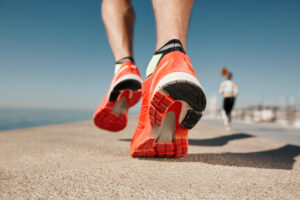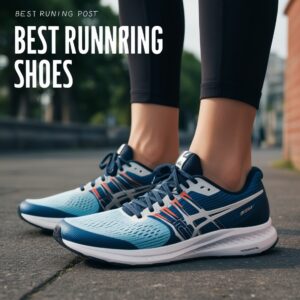Finding the best running shoes can transform your running experience, improve performance, and protect against injury. With so many brands and models to choose from, it’s important to know what to look for. This guide explores everything you need to know about selecting the best running shoes, including types of running shoes, key considerations before purchasing, and top recommendations from popular brands like Asics, Adidas, Nike, and New Balance.

Why Choosing the Right Running Shoes Matters
The right running shoes can make or break your running journey. Wearing shoes that don’t fit your needs can lead to discomfort, decreased performance, and even injury. On the other hand, the right pair can enhance stability, boost performance, and help you enjoy every step.

The following important points to remember for best running shoe:
When searching for the perfect running shoe, look for specific features that cater to your running style, comfort, and foot structure. Here are the key points to remember:
- Foot Arch Type
- Flat Arch: For those with flat feet, stability or motion-control shoes with strong support are best to reduce overpronation.
- Neutral Arch: Runners with a neutral arch benefit from cushioned shoes that balance comfort with support.
- High Arch: If you have a high arch, shoes with added cushioning and flexibility help absorb shock.
- Cushioning Level
- Different runners prefer varying levels of cushioning. Minimalist runners may opt for lightweight shoes with less cushioning, while long-distance runners usually need more support for impact absorption.
- Running Surface
- Choose trail shoes with rugged soles if you run on rocky or uneven paths. For road running, a lightweight, smooth-soled shoe is ideal, while hybrid shoes work well for mixed terrain.

- Shoe Weight
- Lighter shoes suit speed-focused runners, while a slightly heavier shoe provides added stability and support for longer runs.
- Breathability and Material
- Running shoes made with mesh material or breathable fabrics improve air circulation, keeping your feet dry and comfortable throughout your run.
- Durability
- Ensure your chosen shoes are made with durable materials to withstand wear and tear, especially if you’re logging high mileage weekly.
Types of Running Shoes
Knowing the types of running shoes available can help you narrow down your choices and find the perfect match for your running style and goals.
- Road Running Shoes
- Designed for pavement or hard, flat surfaces, road-running shoes are lightweight and flexible with a smooth sole to provide cushioning and support for long-distance runs.
- Trail Running Shoes
- Made for off-road trails, trail running shoes have a rugged sole with added traction for stability on uneven, rocky, or muddy terrain.
- Cross-Training Shoes
- Cross-training shoes are versatile and can be used for a range of activities, from gym workouts to short runs. They typically have a firmer sole, making them less ideal for long-distance running.

- Minimalist Running Shoes
- With a lighter design and lower heel-to-toe drop, minimalist shoes promote a natural stride but offer less cushioning and support. Suitable for advanced runners accustomed to barefoot-style running.

- Stability and Motion Control Shoes
- Stability shoes provide structured support, ideal for runners with mild overpronation. Motion control shoes, on the other hand, are more rigid and are best for those with severe overpronation.
Top Best Running Shoes from Leading Brands
Now that you know what to look for in running shoes, here are the best options from Asics, Adidas, Nike, and New Balance to help you choose a model that fits your needs.
Best Running Shoes by Asics
Asics is known for its blend of comfort and support, especially appreciated by runners with various needs. Here are the top picks:
- Asics Gel-Nimbus 24
-
- Best For: Neutral runners
- Features: The Gel-Nimbus 24 offers premium cushioning with FlyteFoam technology and gel inserts for maximum shock absorption, making it an ideal choice for long-distance running.

-
- Asics Gel-Kayano 28
- Best For: Stability
- Features: With its high level of stability and gel cushioning, the Gel-Kayano 28 is excellent for overpronators seeking support and comfort on longer runs.

- Asics GT-2000 13 TR
- Best For: Light stability
- Features: The GT-2000 13 is a great all-rounder offering mild stability and cushioned comfort, perfect for daily training and moderate distances.
Best Running Shoes by Adidas
Adidas combines style with high-performance technology, making it a favorite among many runners. Here are the top Adidas running shoes:
- Adidas Ultraboost 22
- Best For: Maximum cushioning
- Features: Known for its responsive Boost cushioning, the Ultra boost 22 delivers energy return and is perfect for long-distance road runners who need extra comfort.


- Adidas Adizero Adios Pro 3
- Best For: Speed and race day
- Features: This ultra-lightweight racing shoe has carbon rods for propulsion and a responsive midsole, making it ideal for competitive runners.
- Adidas Solar Glide 5
- Best For: Everyday training
- Features: With balanced cushioning and stability, the Solar Glide 5 is ideal for daily training runs, providing comfort without compromising support.


Best Running Shoes by Nike
Nike’s innovative designs and technology make it a go-to brand for both beginner and advanced runners. The top Nike running shoes are listed here:
- Nike Pegasus 41 Gore – Tex
- Best For: Versatility
- Features: The Pegasus 41 offers a responsive Zoom Air unit, great support, and a comfortable fit, making it versatile for various running distances and paces.


- Nike React Infinity Run Flyknit 4
- Best For: Injury prevention
- Features: Designed with React foam and a rocker geometry, this shoe helps prevent injury by promoting a stable and smooth stride.


- Nike Zoom Fly 6
- Best For: Competitive racing
- Features: Lightweight and built for speed, the Zoom Fly 6 features Nike’s ZoomX foam and a carbon-fiber plate for maximum energy return.


Best Running Shoes by New Balance
New Balance offers innovative designs, balancing comfort with performance. Here are the top picks:
- New Balance Fresh Foam 1080v14
- Best For: Long-distance comfort
- Features: With Fresh Foam cushioning, the 1080v14 provides a plush, smooth ride perfect for long-distance runners.


- New Balance FuelCell Rebel v4
- Best For: Speed and agility
- Features: Lightweight with FuelCell technology, the Rebel v4 is ideal for runners focused on speed, making it a great choice for race training.

- New Balance 880v12
- Best For: All-around daily training
- Features: Known for its versatility, the 880v12 offers balanced cushioning and stability for everyday training across various distances.

Tips for Maintaining Your Running Shoes
Your running shoes are an investment in your health and performance. To increase their lifespan, adhere to these easy-care guidelines:
- Rotate Your Shoes: Avoid using the same pair every day to prevent wear on specific areas and let the foam recover.
- Avoid Extreme Conditions: Excessive sun exposure and extreme heat can degrade the materials. Keep them in a cool, dry place.
- Clean Regularly: Remove dirt and debris after every run, and occasionally hand-wash with mild soap to keep them fresh.
- Monitor for Wear: Pay attention to the tread and cushioning. If they look worn or feel less supportive, it may be time for a replacement.
Conclusion
Selecting the best running shoes can be a game-changer in your running routine. Understanding your foot type, running style, and preferred features can lead you to the ideal pair from reputable brands like Asics, Adidas, Nike, and New Balance. Whether you’re a beginner, an advanced runner, or someone in between, the right pair of shoes offers comfort, reduces injury risk, and enhances your performance. Prioritize your needs, keep these tips in mind, and you’ll be on the right track to finding the perfect fit.
FAQs
- How frequently should my running shoes be replaced?
Running shoes generally need replacing every 300-500 miles or when you notice a decline in support and cushioning. - What is pronation, and why does it matter in choosing running shoes?
Pronation refers to the way your foot rolls inward upon landing. Proper shoe selection based on pronation helps prevent injuries and improves comfort. - Are expensive running shoes worth it?
Yes, quality often aligns with price in running shoes. Investing in a well-cushioned, supportive pair can improve performance and reduce injury. - Can I use the same running shoes for trails and roads?
While it’s possible, road and trail shoes have distinct designs. For regular trail runs, it’s better to use trail-specific shoes for optimal grip and durability. - What distinguishes between neutral running shoes from stability shoes?
Stability shoes offer added support for overpronators, while neutral shoes cater to runners with a natural foot motion and typically provide more cushioning.
For shoe cleaning guide Click here.
